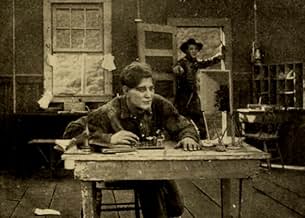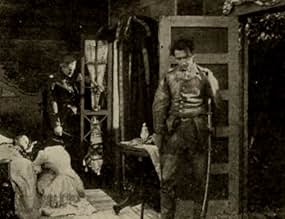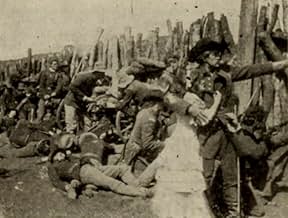Aggiungi una trama nella tua linguaThe U.S. Army and the Indians sign a peace treaty. However, a group of surveyors trespass on the Indians' land and violate the treaty. The Army refuses to listen to the Indians' complaints, ... Leggi tuttoThe U.S. Army and the Indians sign a peace treaty. However, a group of surveyors trespass on the Indians' land and violate the treaty. The Army refuses to listen to the Indians' complaints, and the surveyors are killed by the Indians. A vicious Indian war ensues, culminating in a... Leggi tuttoThe U.S. Army and the Indians sign a peace treaty. However, a group of surveyors trespass on the Indians' land and violate the treaty. The Army refuses to listen to the Indians' complaints, and the surveyors are killed by the Indians. A vicious Indian war ensues, culminating in an Indian attack on an army fort.
- Regia
- Sceneggiatura
- Star
Recensioni in evidenza
The main story starts with a Native American tribe that puts its confidence in a treaty with the US government, only to find out very shortly that they have been deceived. The further developments from this setup are intertwined with some romantic sub-plots involving characters from both groups. These romances are used mostly to drive the action, but at times they are also used to illustrate some worthwhile ideas.
"The Invaders" is very good for its time in telling a fairly involved story with good technique, and in using good, detailed settings that work well. Except for the sometimes plain-vanilla characters, it is well above the average quality of movies made in 1912. It is also worth seeing for the action and the interesting story.
This film was produced at the famous Thomas Ince ranch, one of Hollywood's first great studios, then still in its first year of operation. It was directed either by Ince himself or by Francis Ford, John's older brother, who plays the prominent role of the cavalry commandant Colonel Bryson. Bryson's daughter is courted by a handsome young soldier, and this subplot is presented in direct correlation with the courtship of the Sioux Chief's daughter by a young brave: a parallel that humanizes the Indians for contemporary audiences who may have been accustomed to seeing them typically portrayed as blood-thirsty savages played by white actors in "red-face." This, plus the film's emphasis on treaties signed and then broken by the whites, shows a sympathy for the Indians' cause that may come as a surprise to latter-day viewers, although sympathy for the Indians and indignation over the injustices they suffered seems to have been more common in the silent days than it would be later on. Significantly, the "invaders" of the title are white surveyors sent by the railroad onto Indian land, in violation of a recently signed treaty. Early on, one of the surveyors spots the Chief's daughter and engages in a flirtation with her. It's a sweet scene for a moment or two, but we quickly feel a sense of dread, a premonition that this courtship can only lead to trouble, and soon enough that premonition is fulfilled.
The Invaders has recently been made available as part of an excellent box set of DVDs called "More Treasures from American Film Archives." It's offered with a commentary track by a history professor named Rennard Strickland, and while his remarks were interesting I question his conclusion that the ending is a happy one. He was referring to the finale in which some of the cavalry fort's defenders are rescued, so it's certainly a happy ending for them, but in a broader sense the conflict between the Native Americans of the plains states and the U. S. Government did not end happily for all parties, and anyone with any feeling for the fate of the Oglala Sioux will be saddened by the time this movie is over. Still, we can be grateful The Invaders survives: it stands as the cinema's first great Western epic as well as a fascinating historical time capsule that captures a way of life in its final stages.
John Ford, the director with the most Oscars, had an older brother, Francis, who appears as the Colonel in "The Invaders." Francis, who served in the Army during the Spanish-American War, gravitated towards film soon after and worked under Ince out West as a director/actor. He was involved in close to 400 films. Today's viewers may know him as the old man dying on his deathbed in John Ford's "The Quiet Man," only to wake up, get out of bed and run towards the epic fist fight occurring outdoors between John Wayne and Victor McLaglen.
Ford was part of a massive enterprise run by Thomas Ince, a former actor-turned-director who took the reigns of New York Picture Company's western operations, Bison Studios. Once Ince arrived in Los Angeles, he got his employers to agree to lease 18,000 acres between Santa Monica and Malibu where he could realize his dream of reinventing the way movies could be made. He immediately had numerous simple sets built, creating every imaginary backdrop to serve all types of film categories. He hired literally an entire army of wild west show actors with its livestock from Oklahoma as well as an entire Sioux tribe numbering 200.
With such overhead expenses, Ince realized Bison would have to pump out a number of films each month using an entirely new production system than what the movie industry had been operating since its inception. No more would the director have deliberate sole control of constructing an entire film. Ince placed a producer in charge to oversee one entire movie, from its beginning to completion. Unique was how a movie originated. A detailed script would be submitted by company writers for approval by the studio executives (mostly Ince). The script, a first in cinema, would describe each movement of its actors, what the title cards would state, and the types of sets required. The producer, with the director's advice, would cast the actors and oversee the process throughout its production. Finally, an editor specializing in slicing a film together would take over the duties that a director would normally do. Hence, this assembly-line method of constructing a movie would allow Ince's studio to release as many as three films a week, over 150 in 1913 alone.
This system would be adopted by major movie studios in the future, assuring an insatiable movie-going public a constant stream of new films for their local theaters.
Lo sapevi?
- QuizOne of the films in the three-disk boxed DVD set called "More Treasures from American Film Archives (2004)," compiled by the National Film Preservation Foundation from five American film archives. This film is preserved by the Library of Congress (from the AFI/Blackhawk collection), has a running time of 41 minutes and an added piano score.
- Citazioni
Title Card: SKY STAR OVERHEARS THE PLAN TO MASSACRE THE WHITES.
- ConnessioniReferenced in Adam Piron: What Is an Indian? (2025)
I più visti
Dettagli
- Data di uscita
- Paese di origine
- Lingue
- Celebre anche come
- The Empire Builders
- Azienda produttrice
- Vedi altri crediti dell’azienda su IMDbPro
- Tempo di esecuzione41 minuti
- Colore
- Mix di suoni
- Proporzioni
- 1.33 : 1





















